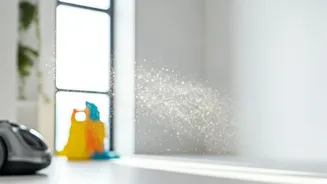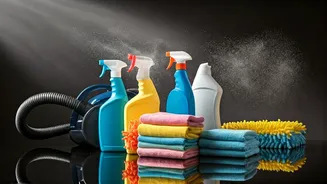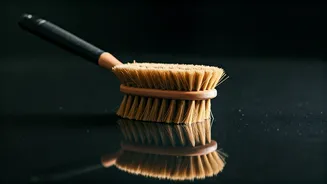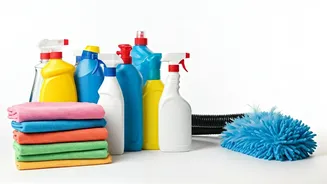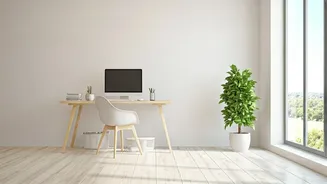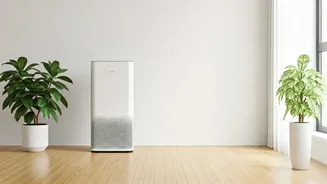Microfiber Reigns Supreme
When it comes to dusting, the cloth you choose makes a huge difference. Ditch those old-fashioned cloths that merely push dust around. Instead, opt for
microfiber cloths. Microfiber cloths are designed with tiny fibers that attract and trap dust particles. This superior design allows them to grab onto dust and grime more effectively, thereby preventing them from simply being redistributed into the air. By employing microfiber cloths, you're not just cleaning; you're actively removing dust and allergens from your home, thus promoting a cleaner, more breathable environment. This approach is significantly more efficient compared to traditional methods and it is a key move in your dust-busting strategy.
Declutter to Detach Dust
One of the most effective and often overlooked methods to manage dust accumulation is decluttering. The fewer items you have on display, the less surface area dust has to settle on. By getting rid of items that you don't use or need, you're not just creating a more spacious home; you are also dramatically reducing the number of places where dust can hide and build up. Consider going through each room, systematically assessing what you own. Donate, sell, or simply discard anything that you no longer need or use. This process doesn't just eliminate clutter, it prevents the buildup of dust that can cause allergy flare-ups.
Fan and Vent Vigilance
Ceiling fans and air conditioning vents often become major dust collection sites within a home. These can easily circulate dust and allergens throughout your living spaces. Regular cleaning of these areas is essential. Begin by turning off the power to the fans before starting. Dust the blades of your ceiling fans at least once a week with a microfiber cloth or a specialized duster. For AC vents, remove the vent covers carefully, and wash them with soap and water. Ensure that they are completely dry before putting them back. Make this a part of your regular cleaning routine. Regular attention to these areas stops dust from being recirculated, and contributes to the improvement of indoor air quality.
Curtains and Cushions Wash
Textiles, such as curtains and cushions, are dust magnets. They readily collect dust, pollen, and other allergens. To counteract this, washing them regularly is crucial. Curtains should be washed at least every three months, or more frequently if you have pets or smokers in your home. Cushions, including those on sofas and chairs, should have their covers removed and laundered regularly, paying attention to the manufacturer's recommendations for cleaning. Vacuuming these items between washes can also help to reduce dust accumulation. By adopting a regular washing schedule for your curtains and cushions, you will significantly minimize the dust and allergens in your home environment.
Shoes at the Door
This is a simple but impactful measure. Implementing a 'shoes-off' policy helps prevent outdoor dirt, pollen, and other pollutants from entering your home. Encourage family members and guests to remove their shoes at the door. Provide a shoe rack or mat near the entrance for convenience. Additionally, consider wiping down the soles of shoes before bringing them indoors if you don't have enough space to store them outside. By removing shoes at the entrance, you reduce the amount of allergens and other pollutants that are tracked into your home, thus contributing to a cleaner and healthier indoor environment. This action is a valuable preventive measure in maintaining a dust-free home.
Natural Dust Spray Power
While commercial cleaning products are an option, natural alternatives are often gentler and more effective. You can create your own anti-dust sprays using ingredients like water, vinegar, and essential oils. The vinegar helps to break down dust and grime, while essential oils provide a pleasant scent and can have antimicrobial properties. Mix equal parts of water and vinegar in a spray bottle, and add a few drops of your chosen essential oil (such as lavender or tea tree). Always test the spray on an inconspicuous area first to ensure it does not damage the surface. These homemade sprays are not only effective but also free of harsh chemicals, making them a safer option for those with allergies or sensitivities.
Hidden Spot Discovery
Don't overlook those hard-to-reach and often-forgotten areas. Dust can accumulate in hidden spots like behind furniture, under appliances, and on top of bookshelves. When cleaning, make sure to move furniture periodically to get to the spots where dust settles. Use a vacuum with a hose attachment or a long-handled duster to reach areas that are hard to reach. Consider using a flashlight to identify dust buildup in dimly lit spaces. The practice of cleaning these areas on a regular basis will enhance the overall cleanliness of your home and improve air quality. Make these spots a part of your routine to ensure no areas are overlooked.
Slow Vacuuming Mastery
Vacuuming is a key part of dust control, but how you do it matters. Vacuuming slowly and deliberately is more effective than rushing through the process. Take your time to go over each area, including carpets, rugs, and hard floors, making sure you are removing the dust. Use attachments like the crevice tool and brush attachments to clean baseboards, upholstery, and other hard-to-reach spots. Remember to vacuum in multiple directions to capture dust from all angles. For allergy sufferers, it is best to use a vacuum cleaner with a HEPA filter, as this will trap the fine particles that can trigger allergic reactions. Regular and thorough vacuuming, done the right way, is one of the essential steps for keeping a dust-free home.
Air Purifier Usage Strategy
Air purifiers can significantly improve indoor air quality, particularly in key areas. Place air purifiers in rooms where you spend a lot of time, such as bedrooms and living rooms. Make sure to choose an air purifier with a HEPA filter to effectively remove dust particles, pollen, and other allergens from the air. Regular filter replacement, according to the manufacturer's instructions, is vital for maintaining the air purifier's effectiveness. Consider moving the air purifier between rooms to provide more comprehensive air purification. Air purifiers, along with these cleaning tips, play a critical role in minimizing allergens and improving your overall respiratory health by creating a cleaner indoor environment.
Closed Storage Solution
Open shelves and storage spaces offer a haven for dust. To minimize dust accumulation, opt for closed storage solutions like cabinets, drawers, and boxes with lids. This will protect your belongings from dust and make cleaning easier. Use storage containers for items that are not frequently used. Ensure all storage areas are regularly cleaned to remove any dust that may accumulate. By choosing closed storage, you're not just reducing dust buildup, you're also creating a more organized and aesthetically pleasing home. This will make cleaning more manageable and contribute to a healthier indoor environment overall, minimizing dust and allergens.


